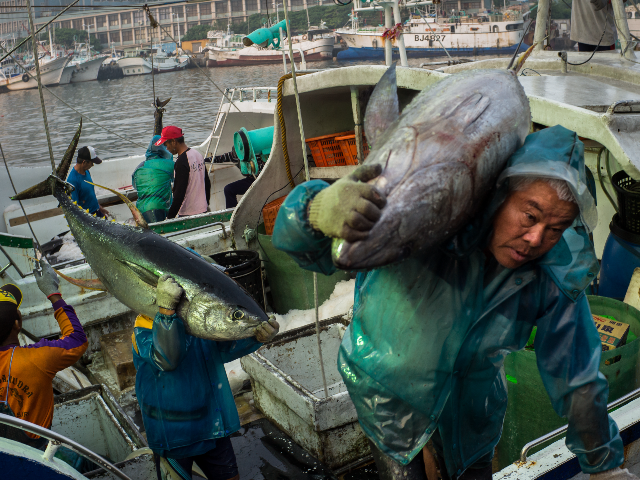Expert: Chinese overfishing in South China Sea threatens ‘everywhere in Southeast Asia’

Billy H.C. Kwok/Getty Images
The director of a think tank dedicated to monitoring the South China Sea said on Friday that overfishing in the body of water, exacerbated by China’s attempted colonization, could damage industries and food security in all of Southeast Asia.
“If fish stocks collapse there, it’s not just going to hit fisherfolk in Palawan and Luzon [Philippine islands]. It’s gonna hit fisherfolk throughout the Philippine archipelago and everywhere in Southeast Asia,” Gregory Poling, director of Washington-based think tank Asia Maritime Transparency Initiative, told a program on the Philippine network ABS-CBN. The Asia Maritime Transparency Initiative regularly monitors satellite images in the South China Sea for suspicious activity and was among the first to reveal that China had begun building artificial islands in Philippine and Vietnamese territory in the sea.
China claims nearly the entire South China Sea. In reality, the sea is mostly international waters, with territory claimed by Brunei, Taiwan, Vietnam, the Philippines, and Malaysia. Indonesia has also become part of the dispute because China claims waters near the exclusive economic zone of Natuna Island, an Indonesian territory.
China has built artificial islands in the Spratly and Paracel Islands, two chains mostly owned by Vietnam and the Philippines. It has filled the maritime territory in the sea with fishing vessels and elbowed out competition from local fishermen who have subsisted on the plentiful fisheries in the region for centuries. It has also caused what some scientists have called “unprecedented” damage to the regional habitat.
“Building new manmade islands on top of shallow reefs is smothering them with sediment, and turning clear water muddy — the environmental damage is substantial and unprecedented in scale,” Professor Terry Hughes, a marine biologist who specializes in coral, told the Guardian in 2015, when the islands were first being built.
“The Chinese heavily subsidized fishers to go out to the Paracel and Spratly Islands. Vietnam does the same and even if parties wanted to do something about it, it’s impossible to enforce fishery rules out there,” Poling said.
The Philippine Star noted that China is threatening the South China Sea’s environment through “verfishing, dredging, island-building and destructive clam harvesting.”
The Philippines sued the Chinese communist regime in April for the illegal clam harvesting. This is occurring in the Scarborough Shoal, an indisputably Philippine sovereign territory that China has claimed for itself. At the time, ABS-CBN found evidence of more than a dozen fishing boats extracting “pile upon pile” of giant claims from the waters around the shoal.
The Philippines has already taken China to court for illegally colonizing its territory. In 2016, the Permanent Court of Arbitration at the Hague ruled that China’s presence in the South China Sea, and particularly the Spratly and Paracel Islands, must come to an end. The Chinese Communist Party called the ruling a “farce” and has largely ignored it, continuing to build facilities in the sovereign territory of other nations and destroy the regional ecosystem.
The South China Sea boasted a rich, diverse biological environment of thousands of species of fish and coral. Since China moved in and began to dredge to create its islands, “fisheries are collapsing,” a marine biologist warned last year.
John McManus of the Rosenstiel School of Marine and Atmospheric Science in Miami told Radio Free Asia (RFA) that dredging has destroyed significant fish habitats, killing many that get swept up in the sand.
“Millions of Southeast Asians depend on the sea’s fishing grounds for their food security,” RFA noted at the time. “According to McManus, the decline of the fisheries worries all of the nations involved, particularly because of the implications for huge numbers of potentially unemployed fishers.”
The Georgetown Environmental Law Review warned in a blog post last year that China’s methods in the region could lead to environmental disaster.
“China uses an especially harmful process to build these islands,” the post read. “Second, the conflict has caused claimant-countries to encourage their people to fish with the goal of strengthening the territorial claims of these countries. … Third, the militarization of the South China Sea dispute has increased air and water pollution.”
The London-based International Institute of Strategic Studies (IISS) found evidence last year that, independent of the dredging and building of artificial islands, China is working to flood the South China Sea with military vessels, including “maritime militia” ships that appear superficially civilian, to wholly control the region. The South China Sea is one of the world’s most trafficked industrial sea routes, meaning controlling its waters would empower China over a significant percentage of global trade.
China insists, without evidence, that it has controlled the entire South China Sea for most of human history.
“The islands and reefs in the South China Sea are Chinese territory since ancient times,” Chinese Communist Party leader Xi Jinping said in 2015. “They are left to us by our ancestors. The Chinese people will not allow anyone to infringe on China’s sovereignty and related rights and interests in the South China Sea.”
Follow Frances Martel on Facebook and Twitter.